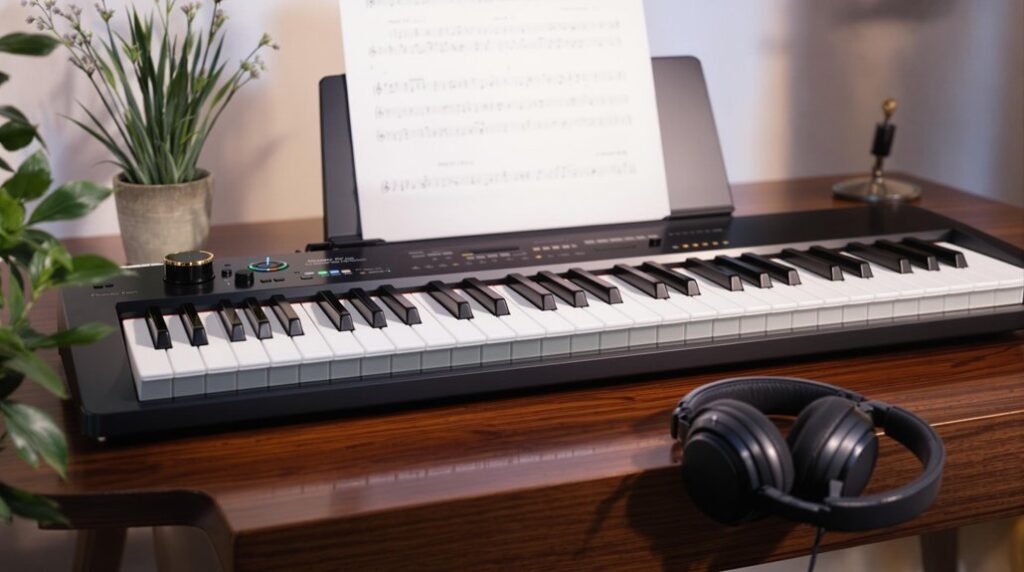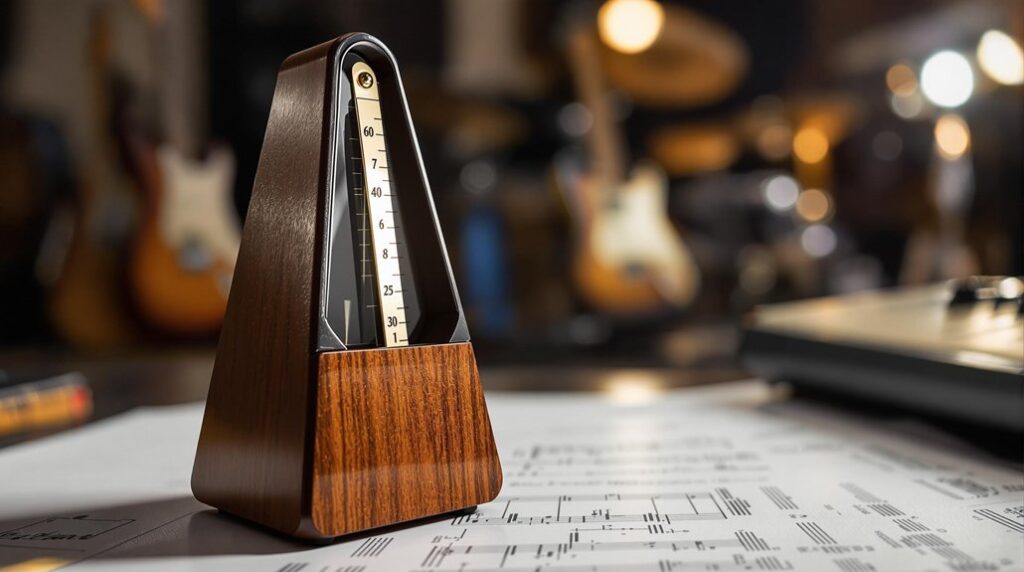Applying basic music theory in your DAW setup can transform your production process. Start by mapping melodies using the piano roll for precise MIDI arrangements and explore counterpoint to enrich texture. Harmonize by extending chords with 7ths or 9ths, and apply voice leading to create smooth shifts between progressions. Utilize scales and modal interchange for emotional depth and maintain structured song forms to guide listener engagement. Integrate digital arrangements through mastering plugins and coherent voice leading. Understanding these principles not only enhances compositions but keeps them in line with contemporary industry trends. There’s much more to discover in deepening your creative practice.
Key Takeaways
- Use the piano roll to arrange and edit MIDI notes for precise melodic and harmonic structure.
- Apply voice leading techniques to ensure smooth transitions between chords and melodic lines.
- Explore scale modes like Dorian and Mixolydian to add unique emotional dimensions to your music.
- Incorporate chord extensions like 7ths, 9ths, or 11ths to enrich harmonic depth and emotional resonance.
- Structure your tracks with clear song sections to create a cohesive and engaging narrative flow.
Understanding Melodic Structures
Understanding melodic structures is a foundational element in music production, especially when using a Digital Audio Workstation (DAW). Comprehending music theory and utilizing DAW software allows composers to craft melodies with precision.
By employing melody mapping, producers can visualize melodic trajectories, guaranteeing that each line has distinct direction and purpose. The DAW’s piano roll becomes an essential tool, where MIDI notes can be arranged to outline the melody’s skeleton, enabling quick adjustments and refinements.
Implementing counterpoint basics can further enhance the composition by weaving independent melodic lines that work harmoniously. The strategic use of MIDI notes guarantees that melodic structures are cohesive, ultimately leading to compositions that captivate listeners without overshadowing other musical elements, maintaining a balance between creativity and structure. Additionally, understanding the role of melody in creating memorable hooks is vital for effective compositions that resonate with audiences.
Harmonizing With Chords
In the domain of harmonizing with chords within your DAW, incorporating chord extensions such as 7ths, 9ths, or 11ths can substantially enrich harmonic depth and complexity.
By utilizing voice leading techniques, you achieve seamless shifts that contribute to a cohesive auditory experience, while strategic use of chord inversions transforms bass lines, adding dynamic texture and movement.
As industry trends increasingly favor compositions with intricate harmonic layers, mastering these techniques is essential for crafting engaging and innovative musical environments. Additionally, understanding musical scales allows for the creation of melodies that resonate emotionally with listeners.
Enhancing Depth With Extensions
Although often overlooked by novice producers, chord extensions serve as a powerful tool in enhancing depth and emotional resonance within a composition. By integrating extensions such as seventh, ninth, or eleventh notes, producers can enrich harmonic textures, transforming simple chord progressions into more complex and engaging soundscapes.
Applying inversions allows for the alteration of bass notes without losing harmonic integrity, thereby adding depth and variation. This practice is pivotal in modern music production, where innovative harmonies are prized for their ability to captivate listeners.
Additionally, voice leading can further refine these progressions, ensuring seamless movement between chords. Embracing these techniques not only raises musicality but also aligns with industry trends that favor rich, expressive compositions.
Smooth Transitions via Voice Leading
Why is voice leading such a critical component in crafting smooth shifts within music compositions? Voice leading facilitates seamless changes by arranging chords so that individual melodic lines glide effortlessly, minimizing leaps and enhancing cohesion. In music, utilizing common tones between chords creates fluid harmonic progressions. This guarantees a compelling listening experience by maintaining a stepwise motion in inner voices, while outer voices move freely, balancing texture and clarity. Techniques like leading and passing tones further refine these changes, contributing to the harmony’s overall flow.
| Technique | Benefit | Example |
|---|---|---|
| Common Tones | Enhances fluidity | C to Am |
| Stepwise Motion | Balances texture | G to Em |
| Leading Tones | Creates smooth changes | D7 to G |
Incorporating these strategies within your DAW setup guarantees innovative and engaging harmonizations.
Textural Variation Through Inversions
Chords’ inversions reveal a new dimension of textural variation in music composition, offering a sophisticated method to enrich harmonic interest. By rearranging chord notes, inversions enhance harmonic texture and create smoother shifts, essential for engaging arrangements.
Inversions, particularly in first and second forms, allow for innovative bass lines that deepen emotional depth, significant when moving between sections. This technique maintains listener engagement by altering harmonic texture without changing fundamental progressions.
In the domain of DAW setups, experimenting with inversions introduces fresh sonic elements, cultivating dynamic and enthralling experiences. Effective use of inversions aids in voice leading, ensuring seamless changes between chords, thereby enhancing musical flow.
Integrating these techniques aligns with current industry trends towards more sophisticated and emotionally resonant compositions.
Utilizing Scales
To effectively utilize scales within your DAW setup, begin by exploring various scale modes like Dorian and Mixolydian, which can introduce unique emotional dimensions to your compositions.
Implementing pitch quantization techniques can further refine your work by ensuring precise alignment of notes with the chosen scale, thereby enhancing the cohesion of your musical ideas.
As industry trends continue to emphasize innovative sound design, strategically constraining your melodic writing to specific scales can reveal distinctive patterns and motifs, enriching both the melody and harmony of your tracks. Understanding modal interchange allows for innovative harmonic shifts that can elevate the emotional engagement in your music.
Exploring Scale Modes
How can the mastery of scale modes transform your digital audio workstation (DAW) setup into a powerhouse of creative expression?
By integrating the seven main scale modes—Ionian, Dorian, Phrygian, Lydian, Mixolydian, Aeolian, and Locrian—composers can write music that resonates with emotional depth and variety.
These scale modes allow for crafting audio tracks with different instruments, utilizing plugins available in modern DAWs to harness their unique tonal qualities.
For instance, the Ionian mode offers a bright, uplifting sound, ideal for pop compositions, while the Dorian mode infuses tracks with a jazzy, funky vibe.
The Phrygian mode introduces an exotic, mysterious atmosphere.
Mastery of these modes fosters innovation, transforming your DAW into a canvas for limitless musical exploration.
Pitch Quantization Techniques
Revealing the full potential of your digital audio workstation involves mastering pitch quantization techniques, a process that aligns recorded notes to specific scale degrees, ensuring melodies fit seamlessly within the chosen tonal framework. By utilizing pitch quantization in a DAW, musicians can enhance melodic coherence, confining notes to selected scales and chords, thereby preventing dissonance. Features like “Snap to Scale” facilitate this, creating harmonically rich melodies.
Experimenting with different scale modes allows for varied emotional expressions, fostering innovative melodic patterns.
| Aspect | Benefit |
|---|---|
| Snap to Scale | Easier harmonic alignment |
| Experimentation with Modes | Varied emotional expressions |
| Melodic Coherence | Enhanced harmonic integrity |
| Regular Practice | Improved compositional skills |
Regular practice with pitch quantization refines compositional intuition, enriching music production skills overall.
Crafting Song Form
Why is song form essential in music production? Crafting a well-defined song form is fundamental to boosting emotional impact and maintaining listener engagement.
By structuring your track into clear sections—such as verses, choruses, and bridges—you can create a narrative flow that resonates with the audience. Dynamic changes between these sections, like build-ups or drops, are crucial for maintaining energy levels and guaranteeing the song remains enchanting.
Additionally, pre-choruses can be used to heighten intensity, leading into choruses that are both impactful and memorable. By balancing energy levels and melodic contrasts, especially between verses and choruses, producers can craft a cohesive and compelling song form. Effective manipulation of dynamic transitions enhances audience connection and ensures that each song section contributes to an engaging listening experience.
Ear Training
Ear training is an indispensable skill for music producers aiming to enhance their DAW compositions with precision and creativity. By honing your ear training abilities, you can effectively identify melodic and harmonic structures essential for crafting cohesive compositions.
Practicing interval recognition is important, as it sharpens your ability to intuitively choose notes that complement your scales. Through consistent analysis of favorite tracks, producers can gain insights into successful music theory applications, enriching their own productions.
Utilizing ear training apps offers structured exercises to develop recognition of chord progressions and their emotional nuances. Engaging in interval training further refines melodic composition, as it deepens your understanding of how different note combinations evoke diverse emotions, ultimately enhancing your DAW projects’ expressiveness. Additionally, incorporating solfege techniques into your practice routine can greatly improve your pitch centering and tonal memory.
Digital Arrangements
In the realm of digital arrangements, mastery over scales and chords is indispensable for composers seeking to craft melodies and harmonies that resonate with audiences.
Utilizing a digital audio workstation (DAW) allows Music Producers to seamlessly integrate virtual instruments and add effects, enhancing the emotional texture of a piece.
By employing digital layering techniques, producers create immersive soundscapes that captivate listeners. Effective use of plugins can make arrangements unique, while experimenting with soundbanks and effects leads to innovation.
Techniques such as chord extensions, pedal tones, and rubato timing add depth and dynamism, bringing compositions to life. Understanding voice leading guarantees smooth shifts, maintaining cohesive melodic lines essential for an efficient workflow and making standout musical compositions. Additionally, a solid grasp of chord progressions can significantly influence the emotional direction and overall impact of a track.
Frequently Asked Questions
What Is the DAW Music Theory?
DAW music theory encompasses the integration of DAW fundamentals, musical scales, MIDI composition, sound design, and audio editing. This knowledge facilitates innovative MIDI compositions, refined sound design, and precise audio editing, aligning with contemporary industry trends and creative practices.
What Are the Basics of DAWS?
The basics of DAWs encompass a thorough DAW features overview, emphasizing MIDI editing basics, audio recording essentials, plugin management strategies, and workflow optimization tips, essential for maximizing creative output and staying aligned with industry trends.
What You Would Use a DAW for in the Mixing Phase?
In the mixing phase, a DAW is instrumental for employing mixing techniques such as track layering, frequency balancing, and effects processing, alongside volume automation, to achieve a cohesive, dynamic sound that aligns with current industry trends.
What Is the Simplest DAW to Use?
GarageBand is often recognized as the simplest DAW to use, offering a beginner’s guide with a user-friendly interface, essential features, and workflow efficiency. It excels in audio editing, making it ideal for newcomers in music production.
Conclusion
The integration of basic music theory into a digital audio workstation (DAW) setup enhances creative possibilities and technical proficiency. Mastery of melodic structures, chord harmonization, and scales serves as the foundation for innovative songcraft. Attention to song form and ear training further refines the compositional process, while digital arrangements offer a modern approach to music production. This fusion of theory and technology aligns with current industry trends, fostering both artistic expression and professional growth in music production.




